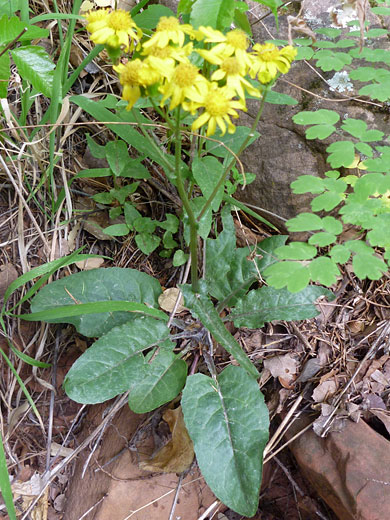Common name:
Arizona ragwort
Family:
Scientific name:
Senecio arizonicus
Main flower color:
Range:
Central Arizona
Height:
Up to 16 inches
Habitat:
Oak-pine woodland; 5,300 to 6,800 feet
Leaves:
Elliptic to ovate, up to 4 inches long and 2.5 inches wide, with small edge teeth
Season:
April to July
Senecio arizonicus usually produces just one stem, typically a little over one foot high, with a group of broad, stalked leaves around the base and a few narrower, clasping leaves along the stem. Flowers are borne on stalks which branch from the top few inches of the stem, the lower stalks longer, so that all flowers are approximately at the same height. Leaves and stems are essentially hairless. Leaves are dark green but can be purplish around the base; leaf stalks are also purple. Leaf edges are lined with shallow teeth, quite well separated.
Plants usually produce between 5 and 12 flowerheads, which have a few short, narrow bractlets radiating out from the base of the involucre. Phyllaries number around 21 (less often around 13); they are green, narrow and stay pressed against the involucre. There are usually 13 ray florets, a little less than half an inch long, and several dozen disc florets.
Plants usually produce between 5 and 12 flowerheads, which have a few short, narrow bractlets radiating out from the base of the involucre. Phyllaries number around 21 (less often around 13); they are green, narrow and stay pressed against the involucre. There are usually 13 ray florets, a little less than half an inch long, and several dozen disc florets.
All Contents © Copyright The American Southwest | Comments and Questions | Contribute | Site Map



